The global AI in government and public services market is forecasted to grow from USD 26.4 billion in 2025 to approximately USD 135.7 billion by 2035, recording an absolute increase of USD 109.3 billion over the forecast period. This translates into a total growth of 414.4%, with the market forecast to expand at a CAGR of 17.8% between 2025 and 2035. The overall market size is expected to grow by nearly 5.14X during the same period, supported by increasing digital transformation initiatives, rising demand for automated government services, and growing focus on citizen engagement and operational efficiency.
Between 2025 and 2030, the AI in government and public services market is projected to expand from USD 26.4 billion to USD 60.2 billion, resulting in a value increase of USD 33.8 billion, which represents 30.9% of the total forecast growth for the decade. This phase of growth will be shaped by accelerating digital government initiatives, increasing investment in smart city infrastructure, and growing adoption of AI-powered citizen services. Government agencies are expanding their AI implementation to address the growing demand for efficient, transparent, and accessible public services.
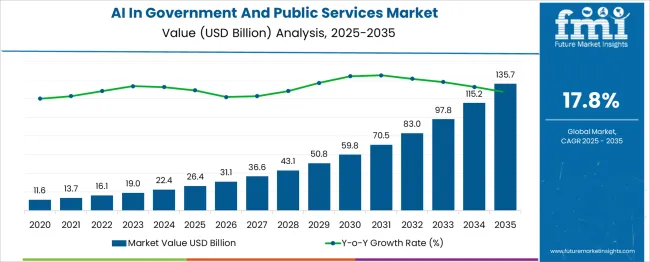
| Metric | Value |
| Estimated Value in (2025E) | USD 26.4 billion |
| Forecast Value in (2035F) | USD 135.7 billion |
| Forecast CAGR (2025 to 2035) | 17.8% |
From 2030 to 2035, the market is forecast to grow from USD 60.2 billion to USD 135.7 billion, adding another USD 75.5 billion, which constitutes 69.1% of the overall ten-year expansion. This period is expected to be characterized by widespread AI integration across government departments, development of sophisticated predictive analytics systems, and implementation of advanced automation in public service delivery. The growing adoption of AI-driven decision support systems and intelligent process automation will drive demand for comprehensive AI solutions with enhanced security and compliance features.
Between 2020 and 2025, the AI in government and public services market experienced robust expansion, driven by the accelerated digital transformation prompted by global events and the increasing need for remote government services. The market developed as government agencies recognized the potential of AI to improve service delivery, reduce operational costs, and enhance citizen engagement. Public sector organizations began emphasizing the importance of AI in modernizing legacy systems and creating data-driven governance models.
Market expansion is being supported by the increasing pressure on government agencies to modernize their operations and deliver more efficient, citizen-centric services. Modern governments are increasingly focused on leveraging AI technologies to automate routine tasks, improve decision-making processes, and provide personalized services to citizens. AI's proven capabilities in processing large volumes of data, identifying patterns, and generating insights make it an essential tool for addressing complex public sector challenges.
The growing emphasis on digital transformation and smart governance is driving demand for AI solutions that can integrate with existing government infrastructure while ensuring data security and privacy. Government initiatives to improve transparency, reduce bureaucracy, and enhance service accessibility are creating opportunities for innovative AI applications. The rising importance of data-driven policymaking and evidence-based governance is also contributing to increased AI adoption across different government departments and public service organizations.
The market is segmented by deployment outlook, technology outlook, end use outlook, application outlook, and region. By deployment outlook, the market is divided into cloud and on-premises. Based on technology outlook, the market is categorized into machine learning (ML), natural language processing (NLP), computer vision, and others. In terms of end use outlook, the market is segmented into government agencies and public services organizations. By application outlook, the market is classified into public safety and security, administrative services, healthcare and social services, smart cities and infrastructure, and others. Regionally, the market is divided into North America, Europe, East Asia, South Asia & Pacific, Latin America, and Middle East & Africa.

The government agencies segment is projected to account for 65% of the AI in government and public services market in 2025, reaffirming its position as the primary adopter of AI technologies in the public sector. Federal, state, and local government agencies are increasingly implementing AI solutions to streamline operations, improve service delivery, and enhance decision-making processes. These agencies are leveraging AI for various applications including citizen service automation, fraud detection, resource optimization, and policy analysis.
This segment forms the foundation of public sector AI adoption, as government agencies possess the resources, infrastructure, and mandate to implement large-scale digital transformation initiatives. The ongoing modernization of government IT systems and the push for digital-first service delivery continue to drive AI implementation. With increasing citizen expectations for efficient, accessible, and personalized government services, government agencies are positioned to remain the dominant force driving AI adoption in the public sector.
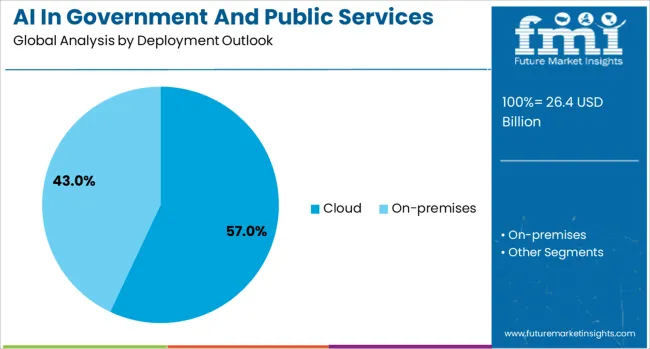
Cloud deployment is projected to represent 57% of AI in government and public services demand in 2025, underscoring the shift toward flexible, scalable, and cost-effective infrastructure solutions. Government organizations gravitate toward cloud-based AI platforms for their ability to handle large-scale data processing, provide real-time analytics, and enable remote access to services. Cloud deployment offers advantages including reduced infrastructure costs, automatic updates, enhanced collaboration capabilities, and the ability to scale resources based on demand.
The segment is supported by government cloud-first policies and the increasing availability of secure, compliant cloud platforms designed specifically for public sector use. Additionally, cloud providers are offering specialized government cloud environments that meet stringent security and compliance requirements, including data sovereignty and privacy regulations. As government agencies prioritize agility and innovation while managing budget constraints, cloud-based AI solutions will continue to dominate deployment preferences, reinforcing their position as the preferred infrastructure choice for public sector AI initiatives.
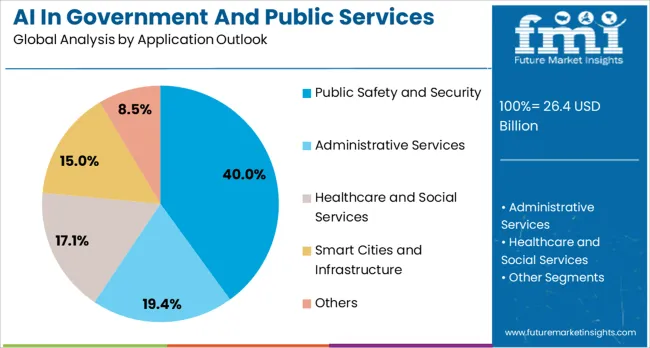
The public safety and security application is forecasted to contribute 40% of the AI in government and public services market in 2025, reflecting the critical importance of protecting citizens and maintaining social order. Government agencies are increasingly deploying AI technologies for threat detection, emergency response optimization, crime prediction, and surveillance system enhancement. This application area encompasses various use cases including facial recognition for security purposes, predictive policing, disaster response coordination, and cybersecurity threat detection.
The segment benefits from substantial government investment in national security and public safety infrastructure, driven by evolving security challenges and the need for proactive threat prevention. AI-powered systems enable law enforcement and emergency services to analyze vast amounts of data from multiple sources, identify patterns, and respond more effectively to incidents. With heightened focus on public safety and the increasing sophistication of security threats, AI applications in safety and security serve as a critical priority, making them a fundamental driver of technology adoption in the government sector.
The AI in government and public services market is advancing rapidly due to increasing digital transformation initiatives and growing demand for efficient public service delivery. However, the market faces challenges including data privacy concerns, regulatory compliance requirements, and resistance to change within traditional government structures. Innovation in AI technologies and evolving governance frameworks continue to influence implementation strategies and market expansion patterns.
The growing emphasis on digital government transformation is enabling agencies to reimagine service delivery and citizen engagement through AI-powered solutions. Governments worldwide are implementing comprehensive digital strategies that prioritize user experience, accessibility, and service efficiency. These initiatives are driving adoption of AI technologies for automating routine processes, personalizing citizen interactions, and providing 24/7 digital services through intelligent chatbots and virtual assistants.
Modern government AI implementations are incorporating sophisticated analytics and predictive modeling to enhance policy-making and resource allocation. These technologies enable governments to analyze complex datasets, forecast trends, and make data-driven decisions that improve public outcomes. Advanced analytics platforms also support evidence-based policymaking, performance monitoring, and early warning systems for various social, economic, and environmental challenges.

| Country | CAGR (2025-2035) |
| China | 24.0% |
| India | 22.3% |
| Germany | 20.5% |
| France | 18.7% |
| UK | 16.9% |
| USA | 15.1% |
| Brazil | 13.4% |
The AI in government and public services market is experiencing robust growth globally, with China leading at a 24.0% CAGR through 2035, driven by massive government investment in AI infrastructure, smart city development, and digital governance initiatives. India follows at 22.3%, supported by digital India programs, growing e-governance adoption, and increasing focus on AI-powered citizen services. Germany shows strong growth at 20.5%, emphasizing digital administration and intelligent public services. France records 18.7%, focusing on national AI strategy implementation and public sector innovation. The UK demonstrates 16.9% growth, prioritizing digital transformation and data-driven governance. The USA shows 15.1% growth, driven by federal modernization initiatives and state-level digital government programs. The report covers an in-depth analysis of 40+ countries; top-performing countries are highlighted below.
Revenue from AI in government and public services in China is projected to exhibit strong growth with a CAGR of 24.0% through 2035, driven by comprehensive national AI strategy and substantial government investment in smart city infrastructure. The country's centralized governance model enables rapid deployment of AI technologies across various government departments and public services. Major technology companies are collaborating with government agencies to develop sophisticated AI solutions for urban management, public safety, and citizen services.
Revenue from AI in government and public services in India is expanding at a CAGR of 22.3%, supported by ambitious digital transformation programs, growing technology infrastructure, and increasing focus on inclusive governance. The country's Digital India initiative and emphasis on e-governance are driving widespread adoption of AI technologies for citizen services, administrative efficiency, and policy implementation. Government agencies are partnering with technology providers to develop localized AI solutions addressing unique demographic and linguistic diversity challenges.
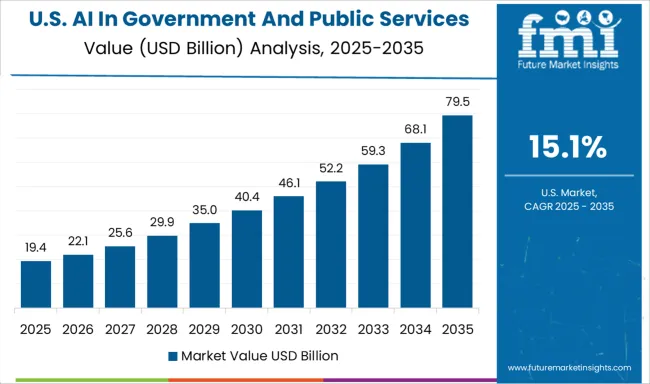
Demand for AI in government and public services in the USA is projected to grow at a CAGR of 15.1%, supported by federal IT modernization initiatives and increasing focus on evidence-based policymaking. American government agencies are implementing AI solutions to improve service delivery, enhance cybersecurity, and optimize resource allocation. The market is characterized by strong emphasis on ethical AI implementation, transparency, and citizen privacy protection.
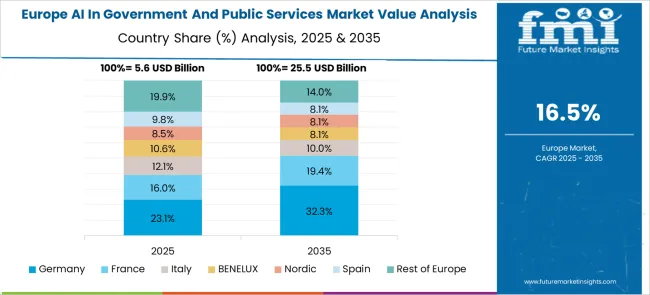
Revenue from AI in government and public services in Germany is forecasted to grow at a CAGR of 20.5% through 2035, driven by the country's comprehensive digital agenda and focus on administrative modernization. German government agencies consistently prioritize efficiency, transparency, and citizen-centric service design in their AI implementations.
Revenue from AI in government and public services in the UK is projected to expand at a CAGR of 16.9% through 2035, supported by strong government commitment to digital transformation and innovative public service delivery. British government departments value user-centric design, accessibility, and service efficiency, positioning AI as a critical enabler of modern governance.
Revenue from AI in government and public services in France is expected to grow at a CAGR of 18.7% through 2035, supported by the country's ambitious national AI strategy and commitment to public sector modernization. French government agencies prioritize sovereign AI capabilities, ethical implementation, and citizen benefit maximization in their technology adoption strategies.
Revenue from AI in government and public services in Brazil is projected to expand at a CAGR of 13.4% through 2035, supported by increasing digital government initiatives and focus on improving public service accessibility. Brazilian government agencies are implementing AI solutions to address challenges in service delivery, reduce bureaucracy, and enhance citizen engagement across diverse geographic and socioeconomic contexts.
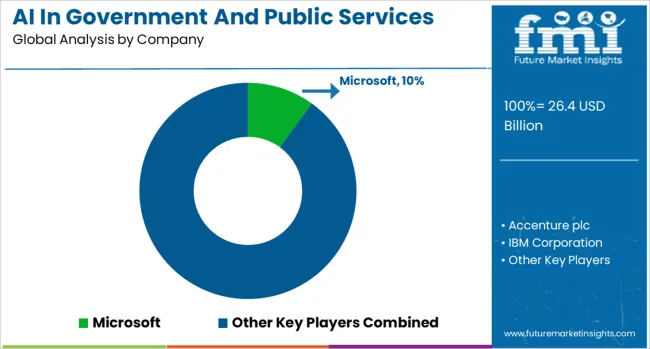
The AI in government and public services market is characterized by competition among technology giants, specialized government contractors, consulting firms, and emerging AI startups. Companies are investing in secure infrastructure, compliance frameworks, specialized algorithms, and domain expertise to deliver effective, reliable, and compliant AI solutions for public sector requirements. Strategic partnerships, government certifications, and proven implementation track records are central to strengthening market position and winning government contracts.
Microsoft, USA-based, leads the market with 10.0% global value share, offering comprehensive AI platforms with enterprise-grade security and compliance features tailored for government use. Accenture plc provides end-to-end AI consulting and implementation services with deep public sector expertise and global delivery capabilities. IBM Corporation delivers AI solutions combining Watson technologies with extensive government sector experience and security clearances. Google LLC offers cloud-based AI services with advanced machine learning capabilities and scalable infrastructure for government applications.
OpenAI provides cutting-edge language models and AI technologies increasingly adopted for government automation and citizen service applications. Palantir Technologies Inc. specializes in data analytics and AI platforms designed specifically for government intelligence and defense applications. Deloitte Touche Tohmatsu Limited offers comprehensive consulting services combining AI expertise with public sector transformation experience. Booz Allen Hamilton Inc. provides strategic consulting and AI implementation services with focus on federal government and defense sectors. C3.ai, Inc. delivers enterprise AI software platforms optimized for large-scale government deployments and complex use cases.
| Items | Values |
|---|---|
| Quantitative Units (2025) | USD 26.4 billion |
| Deployment Outlook | Cloud, On-premises |
| Technology Outlook | Machine Learning (ML), Natural Language Processing (NLP), Computer Vision, Others |
| End Use Outlook | Government Agencies, Public Services Organizations |
| Application Outlook | Public Safety and Security, Administrative Services, Healthcare and Social Services, Smart Cities and Infrastructure, Others |
| Regions Covered | North America, Europe, East Asia, South Asia & Pacific, Latin America, Middle East & Africa |
| Countries Covered | United States, Canada, United Kingdom, Germany, France, China, Japan, South Korea, India, Brazil, Australia and 40+ countries |
| Key Companies Profiled | Microsoft, Accenture plc, IBM Corporation, Google LLC, OpenAI, Palantir Technologies Inc., Deloitte Touche Tohmatsu Limited, Booz Allen Hamilton Inc., and C3.ai, Inc.,SAS Institute Inc. |
| Additional Attributes | Implementation strategies by agency type and size, regional adoption patterns, competitive landscape, security and compliance requirements, integration with legacy systems, innovations in natural language processing, computer vision applications, and predictive analytics capabilities |
The global AI in government and public services market is estimated to be valued at USD 26.4 billion in 2025.
The market size for the AI in government and public services market is projected to reach USD 135.7 billion by 2035.
The AI in government and public services market is expected to grow at a 17.8% CAGR between 2025 and 2035.
The key product types in AI in government and public services market are cloud and on-premises.
In terms of technology outlook , machine learning (ml) segment to command 30.0% share in the AI in government and public services market in 2025.






Full Research Suite comprises of:
Market outlook & trends analysis
Interviews & case studies
Strategic recommendations
Vendor profiles & capabilities analysis
5-year forecasts
8 regions and 60+ country-level data splits
Market segment data splits
12 months of continuous data updates
DELIVERED AS:
PDF EXCEL ONLINE
AI Document Generator Market Size and Share Forecast Outlook 2025 to 2035
Air Caster Skids System Market Size and Share Forecast Outlook 2025 to 2035
AI Platform Market Size and Share Forecast Outlook 2025 to 2035
AI-Powered Sleep Technologies Market Size and Share Forecast Outlook 2025 to 2035
AI-Powered Gait & Mobility Analytics Market Size and Share Forecast Outlook 2025 to 2035
AI-Powered Behavioral Therapy Market Size and Share Forecast Outlook 2025 to 2035
AI-Enabled Behavioral Therapy Market Size and Share Forecast Outlook 2025 to 2035
Airflow Balancer Market Size and Share Forecast Outlook 2025 to 2035
AIOps Platform Market Forecast and Outlook 2025 to 2035
Aircraft Flight Control System Market Size and Share Forecast Outlook 2025 to 2035
Airborne Radar Market Size and Share Forecast Outlook 2025 to 2035
AI-Powered CRM Platform Market Forecast Outlook 2025 to 2035
AI Animation Tool Market Forecast Outlook 2025 to 2035
Aircraft Electric Motor Market Forecast Outlook 2025 to 2035
Airport Ground Transportation Market Forecast and Outlook 2025 to 2035
AI Image Editor Market Forecast and Outlook 2025 to 2035
Airless Sprayer Accessories Market Size and Share Forecast Outlook 2025 to 2035
Air Purge Valve Market Size and Share Forecast Outlook 2025 to 2035
Air Flow Sensors Market Size and Share Forecast Outlook 2025 to 2035
Air Separation Plant Market Size and Share Forecast Outlook 2025 to 2035

Thank you!
You will receive an email from our Business Development Manager. Please be sure to check your SPAM/JUNK folder too.
Chat With
MaRIA